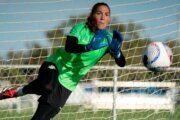The occasional insomniac knows the torture of a missed night of sleep. Now imagine if every morning you woke up groggy and exhausted. For the up to 1 in 3 adults estimated to have obstructive sleep apnea — a condition in which the person momentarily stops breathing at intervals during the night — daytime sleepiness and brain fog is a constant reminder that, even though you might be going to sleep and spending an appropriate amount of time in bed, you aren’t getting good quality rest. And it’s all because those with sleep apnea struggle to breathe properly while asleep.
What Is Sleep Apnea?
Dr. Sheila Tsai, a pulmonologist and section head of sleep medicine at National Jewish Health in Denver says the term sleep apnea usually refers to obstructive sleep apnea, or OSA, a condition in which, “a person’s airway either partially collapses or completely closes (obstructs) during sleep.” These episodes occur through the night, “causing frequent drops in oxygenation and frequent brief awakenings.”
These awakenings are usually momentary and they’re a reflex from the body to help you start breathing again. You might not even realize you’re awake when it happens.
Called arousals, these episodes are “similar to someone shaking you awake,” says Dr. Peter A. Fotinakes, medical director of the Sleep Disorders Center at Providence St. Joseph Hospital in Orange County, California. These arousals cause sleep to be fragmented and non-restorative, “and the end result is daytime sleepiness, which may become as severe as a narcoleptic’s sleepiness.” Narcolepsy is another sleep disorder in which a person falls asleep at inappropriate times.
Sleep apnea is a common sleep disorder. According to a 2022 study in the Journal of Clinical Sleep Medicine, nearly 30 million adults in the United States have sleep apnea, and about 80% of these cases are undiagnosed.
Sleep Apnea Causes
Obesity and age are common sleep apnea causes. As obesity rates continue to increase and the American population ages, it’s believed that the incidence of sleep apnea will also worsen.
Sleep apnea symptoms may include:
— Loud, pervasive snoring broken by hesitations, gasps and snorts.
— Poor sleep.
— Daytime sleepiness.
— Waking up feeling unrefreshed and with a dry mouth.
— Frequent awakenings during sleep.
— Waking up gasping or with the sensation of choking.
— Waking up with morning headaches.
[SEE: Sleep Apnea: 11 Things That Make It Worse.]
Severe Sleep Disruption
Tsai says “obstructive sleep apnea syndrome causes sleep disruption and repetitive decreases in oxygen saturations during sleep.” In addition to feeling unrested and sleepy during the day, “sleep apnea may worsen other sleep disorders such as sleep walking or restless legs syndrome because of the sleep disruption.”
Someone with severe sleep apnea might experience up to 500 arousals over the course of an 8-hour sleep session, Fotinakes says. In “milder” cases, you may have 15 arousals per hour, which means the patient is “still awakening every 4 minutes throughout their sleep period, which produces a significant degree of sleep fragmentation. Consider waking up 120 times during an 8-hour sleep period,” he says.
Sleep apnea tends to be worse and arousals often cluster during periods of REM sleep, Fotinakes says. REM stands for rapid eye movement, and during this phase of sleep, your eyes move rapidly back and forth. It’s also during this deep stage of sleep that you dream.
“We cycle through REM sleep every 70 to 120 minutes,” Fotinakes says. “The duration of each REM period increases with each cycle. Consequently, most REM sleep concentrates during the final hours of sleep, just before awakening.”
If you have sleep apnea, that can delay the onset of REM sleep and reduce the percentage of the night you spend in that restorative, deep stage of sleep. Sleep apnea also “results in a high degree of fragmentation during REM periods,” Fotinakes says.
Sleep Apnea Treatments
There are several effective ways of treating sleep apnea. The most common and usually most effective of these is continuous positive airway pressure therapy, or CPAP. This involves wearing a mask over the mouth and nose while you sleep. The mask is attached to a machine that pumps air into the throat via a hose, thereby inflating the throat and preventing it from collapsing.
That sleep apnea machine “fits tightly over your nose and mouth and is trapped to your face pretty tightly so that there’s not much air leakage,” says Eric Hsiao, chief of the division of pulmonary, critical care and sleep medicine at Santa Clara Valley Medical Center in California.
“It may not be the most comfortable thing to use when they go to sleep, but it can be very effective and people get used to it. Pretty soon, they tell you that they can’t sleep without it,” he says. “That’s the most effective treatment for sleep apnea for all comers.”
But there are other options, including surgery for sleep apnea. Dr. Julia Pfaff, an otolaryngologist with Bayfront Health St. Petersburg Medical Group, Ear, Nose and Throat, in St. Petersburg, Florida, part of the Orlando Health system, says that some patients may undergo nasal airway surgery to correct mild sleep apnea. Mandibular repositioning devices, a type of mouth guard that shifts the jaw to prevent collapsing of the airway during sleep, may also be an option for some people with mild sleep apnea.
“For patients with moderate or severe sleep apnea, there is new innovative technology called the Inspire implant, which is essentially a pacemaker for sleep apnea,” she explains. This device is “surgically implanted to prevent obstruction from the inside out. This is for patients who are unable to tolerate CPAP.”
There are no medications to treat sleep apnea; Hsiao says some people use stimulants to combat sleepiness, but this is not recommended as continual use of stimulant drugs can become dangerous and lead to dependence.
Patients who have overweight or obesity are also typically advised to lose weight to reduce pressure on their airway.
When you finally receive treatment for sleep apnea, your brain will attempt to compensate for the poor sleep you’ve had for months or years prior, Fotinakes says. “It’s not unusual for a person to experience REM periods lasting hours when they are first put on CPAP treatment. Essentially, their brains are starved for REM sleep, so the brain rebounds after elimination of the REM-specific sleep fragmentation caused by sleep apnea.”
Hsiao notes that when you’re first starting with CPAP treatment, “it’s not one size fits all. You’ll have to make sure you get a proper-fitting mask” that fits the individual contours of your face well. And if the first time you try it you don’t like it, keep trying.
[Read: Sleep Reset: Getting Your Sleep Back to Normal.]
Sleep Positions to Improve Sleep Apnea
In addition to treatment from a CPAP machine or other device, you can also make a few changes to your daily life that can have a big impact on the severity of your sleep apnea. For example, everyone has a favorite sleep position, but changing it could help reduce snoring and improve symptoms of sleep apnea.
“I advise people to try to sleep on their side if they can,” Hsiao says, “but for the most part, people can’t really control how they sleep. Once they fall asleep they tend to roll over into whatever position they feel comfortable in.”
Still, it can be worth trying to make the change, he says. While some people recommend sleeping with a tennis ball Velcro-ed to the back of your pajamas so that it becomes uncomfortable to roll onto your back, “I’m not sure that’s all that practical,” he says.
No matter how you achieve it, the best sleeping positions to improve sleep apnea (in order of preference) are:
1. On your side.
2. On your belly.
3. On your back, but only with your head elevated.
“Sleep apnea is often worse in the supine (on your back) position because of gravity,” Tsai says. This happens, Pfaff says, because there’s a “change in the structural integrity in the back of the throat when lying supine, making it much easier for the tongue to fall back into the airway and cause obstruction. It also often results in the jaw falling open, which makes it easier for the tongue to obstruct the airway.”
Fotinakes adds that sleeping on your side or in a prone (on your stomach) position “may lessen or even eliminate snoring and apnea in many cases.”
Sleeping on your stomach can be awkward, and some people who try it find they wake up with a stiff neck. Choosing a very thin pillow or a pillow made specifically for stomach sleepers may help reduce strain on the neck when lying face down.
When sleeping on your side, you’ll likely need a thicker pillow to support the head and neck. Some people prefer to cuddle up to a large body pillow to help keep them in the right position. There are lots of pillows that are marketed specifically for addressing sleep apnea concerns, so do a little research and try out a few to find one that feels right for you.
If you must sleep on your back — some people who have sleep apnea also have acid reflux, and sleeping on your back with your head elevated is often recommended to reduce symptoms of that condition — try elevating the head of the bed, Tsai says.
“Sleeping with the head as elevated and upright as possible, such as with an adjustable bed or recliner, may be helpful in improving sleep apnea symptoms.” Wedge-shaped pillows made of foam rather than a squishier material can help you achieve the right position that keeps the airway more open.
Some people even elevate the head of a conventional bed with bricks or a bed riser to get the necessary height to lessen symptoms of sleep apnea. “In fact, it’s not uncommon for people to present to our sleep clinic saying they can only sleep in a recliner due to their untreated OSA,” Tsai notes.
When adjusting to a new sleeping position, be forewarned that it may take you a period of trial and error to find the best, most comfortable position that alleviates symptoms. Keep trying until you find what works for you. And as Tsai notes, “these measures are often inadequate to fully treat sleep apnea. Patients often need additional therapy, such as positive airway pressure, which helps to prop the airway open during sleep, leading to better sleep and better daytime functioning.”
[READ: Sleep and Aging.]
Bottom Line: Seek Treatment for Sleep Apnea
“Sleep apnea is a serious, yet treatable condition,” Tsai says, so if you’re waking feeling unrefreshed or your sleep partner complains that you’re snoring a lot, talk to a health care provider. A simple, non-invasive sleep study or sleep test — which can sometimes be completed at home — can diagnose the condition.
Pfaff agrees that “untreated sleep apnea is a dangerous health condition, and is often silent. Many patients don’t even realize they have it and are often told by their partners.”
And it’s worth getting checked out because not treating sleep apnea can have significant health consequences, including:
— Excessive sleepiness.
— Increasing mood disorders such as depression and anxiety.
— Worsening memory and loss of ability to concentrate.
— Weight gain.
— Increased risk of cardiovascular disease, including heart arrhythmias, high blood pressure and other heart conditions.
— Increased risk of strokes.
— Metabolic abnormalities.
— Accidents related to sleepiness.
“Untreated OSA can also disrupt and negatively impact the sleep of bed partners,” Tsai says.
While the consequences can be dire, “the good news is that when it’s treated, people can experience overall health benefits, including a decrease in sleepiness and an improvement in sleep quality, mood, concentration and quality of life,” Tsai says. “Treated patients often begin to sleep less, but have higher quality of sleep and feel more rested. “It’s all about the quality, not the quantity, of sleep,” Fotinakes adds.
“If you have sleep apnea and are struggling with the therapy, talk to a sleep specialist who can help troubleshoot your issues and maximize your success with treatment,” Tsai concludes.
More from U.S. News
13 Ways to Solve Sleep Problems in Seniors
7 Signs You’re Tired Other Than Yawning
Natural Ways to Lower Blood Pressure
Best Sleeping Positions to Improve Sleep Apnea originally appeared on usnews.com
Update 12/13/22: This story was previously published at an earlier date and has been updated with new information.







